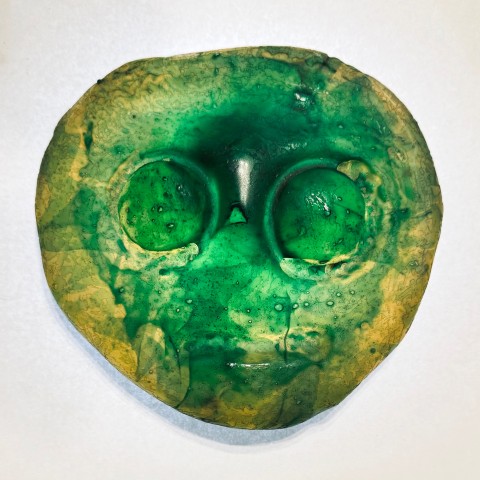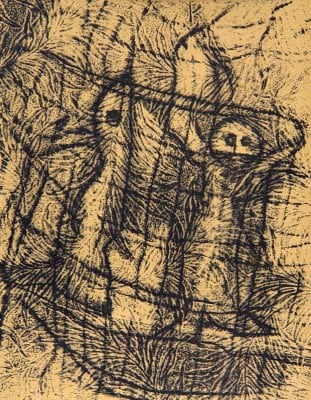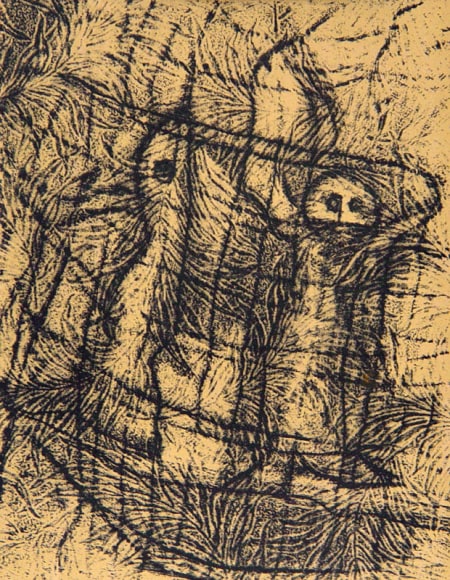
Max Ernst

Un Chant d'amour (The Song of Love), 1958
Max Ernst was born on April 2, 1891 in a small Rhineland town called Bruhl, outside Cologne, Germany. His father, a fiercely authoritarian Roman Catholic, was an amateur painter who taught at a school for deaf-mutes. From earliest childhood, Max Ernst seems to have acquired haunting visual images which became factors in his work throughout his life. He was a nervous impressionable boy, in constant friction with authority. During an illness, Max Ernst stared at the wood flooring and ended up discovering a new painting technique that he called “frottage.” He took paper and pencil, laid them over the textured surface and scribbled away. Allied to this was Max Ernst’s use of paint sponged and knifed on a canvas, with the images it suggested sharpened with a brush.
In 1909, he went to the University of Bonn, studying philosophy and psychiatry at a time when the subject was barely acknowledged as a discipline. After serving in the German artillery in World War I, Max Ernst continued painting, and eventually reached Paris at a time when Dada was in full swing and Surrealism was about to be born. Max Ernst became one of the leading modernist painters in Europe in the early and mid 20th century and was one of the leading figures of the Dada and Surrealist movements in Paris and New York. Many of his paintings reflect the terror that Max Ernst experienced during World War II as well as the style of Surrealism that the artist adopted from French influences.
In Berlin, Max Ernst exhibited in 1913 and by 1919 had founded the Dada group in Cologne, Germany with Hans Arp. He lived in France from 1920 to 1940 and was drawn there to exhibit with the Surrealists led by Andre Breton. In 1925, Max Ernst was in the first Surrealist exhibit in Paris.
Featured works
Biography
Max Ernst’s first wife was the art historian Luise Strauss, who bore him a son Jimmy. He then married high-strung Marie-Berthe Aurenche, who reveled in her status as an illegitimate descendant of Louis XVI. In the late 1930′s, having left his wife and disassociated himself from the Surrealists, Max Ernst spent an idyllic interlude renovating an old farmhouse with his then-lover, painter Leonora Carrington. In 1939, Max Ernst was held in a French prison camp on the false accusation that he was spying. He escaped only to discover that Leonora Carrington had had an emotional breakdown. She had sold his house for a bottle of brandy, leaving him homeless.
In 1940, Max Ernst successfully sought refuge in the United States and lived in New York City where Marcel Duchamp and Andre Breton had also migrated. Together these artist’s founded the Surrealist magazine. Then, a year later Max Ernst married the heiress and art patron Peggy Guggenheim. After the war ended, he divorced Peggy and married artist Dorothea Tanning. During 1943, the couple visited Sedona, Arizona where they stayed for three years. Max Ernst built a house in Arizona and life there resulted in a magnificent series of Arizona mountain paintings which were bleak and burning under their immobile suns.
Max Ernst had a distinct prophetic faculty; immersed in the 20th century and lacking any nostalgia, he could feel what was coming. The artist’s predictive powers also had to do with art style itself. Max Ernst made some small paintings by swinging a punctured can of paint on a string above a canvas flat on the floor; the resulting pattern of drips clearly anticipated Jackson Pollock. There was no chance technique – staining, rubbing, splashing, accidental manipulation, transfer blots – that Max Ernst did not pioneer. His was one of the most durable and fertile talents of our entire culture, a great enemy of the trivial, the bogus and the solemn.
By the early 1950′s, Max Ernst migrated back to Europe and a small house in the south of France, where he did lithographs and engravings. In 1958, the artist became a French citizen. He continued working long after the Dada and Surrealist movements were history. He was the master of invoked accident and controlled chance and even past eighty years old, was still inventing. Max Ernst was never a leader in any serious, ideological sense. Despite his technical ingenuity, he never settled down and fully exploited any of his means; to achieve any of these respectable goals would have tied him down.
Max Ernst died in Paris on April 1, 1976.
Sources include:
Time Magazine, March 5, 1973
Robert Hughes in Time Magazine, April 12, 1976
Peter Hastings Falk (Editor), Who Was Who in American Art
Compiled and written by Jean Ershler Schatz, artist, and researcher of Laguna Woods, California.
Biography from the Archives of AskART.

